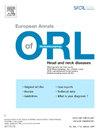使用额内侧和乳突刺激评估骨传导的 oVEMPs。
IF 2.4
4区 医学
Q2 OTORHINOLARYNGOLOGY
European Annals of Otorhinolaryngology-Head and Neck Diseases
Pub Date : 2025-03-01
DOI:10.1016/j.anorl.2024.09.010
引用次数: 0
摘要
目的:确定使用改良裂隙灯支架刺激额部的最佳刺激强度,并比较使用额部内侧和乳突两个刺激部位的骨传导眼前庭诱发肌源性电位(oVEMPs)的可靠性和对称性:这项观察研究包括洛桑大学医院的 33 名健康志愿者(15 名女性,18 名男性;平均年龄 24.5 岁)。参与者接受了耳神经学评估,结果正常者被纳入研究范围。使用 Brüel and Kjaer 4810 型微型振动器记录骨传导 oVEMPs。额部刺激使用改良的裂隙灯支架,以确保施加压力的一致性,同时解放检查者的双手。乳突刺激是手动进行的:在 70 分贝 nHL 时,oVEMP 记录的再现性最好。与乳突刺激(潜伏期高达 40%)相比,额部刺激的数据分散性较低,潜伏期(高达 7%)和振幅(高达 50%)的不对称比率也较低。在额部和乳突部位的单次刺激足以获得两个耳廓的可靠测量结果:结论:使用改良的裂隙灯支架在 70 分贝 nHL 下刺激额部,因其卓越的再现性、舒适性和可靠性,被推荐用于骨传导 oVEMP 记录。这项研究确立了最佳刺激强度的新标准,并支持在临床实践中使用额部刺激。本文章由计算机程序翻译,如有差异,请以英文原文为准。
Evaluation of bone-conducted oVEMPs using frontal medial and mastoid stimulations
Aims
To determine the optimal stimulation intensity for frontal stimulation with a modified slit lamp holder and to compare the reliability and symmetry of bone-conducted ocular vestibular evoked myogenic potentials (oVEMPs) using two stimulation sites: frontal medial and mastoid.
Methods
This observational study included 33 healthy volunteers (15 women, 18 men; mean age 24.5 years) at the University Hospital of Lausanne. Participants underwent otoneurological assessments, and those with normal results were included. Bone-conducted oVEMPs were recorded using a Brüel and Kjaer mini-shaker type 4810. A modified slit lamp holder was used for frontal stimulation to ensure consistent application pressure, freeing the examiner's hands. Mastoid stimulation was performed manually.
Results
The best reproducibility of oVEMP recordings was observed at 70 dB nHL. Frontal stimulation demonstrated lower dispersion of data and lower asymmetry ratios of latencies (up to 7%) and amplitudes (up to 50%) compared to mastoid stimulation (up to 40% for latencies). Single stimulations at both frontal and mastoid sites were sufficient to obtain reliable measurements of both utricles.
Conclusion
Frontal stimulation at 70 dB nHL using a modified slit lamp holder is recommended for bone-conducted oVEMP recordings due to its superior reproducibility, comfort, and reliability. This study establishes a new standard for optimal stimulation intensity and supports the use of frontal stimulation in clinical practice.
求助全文
通过发布文献求助,成功后即可免费获取论文全文。
去求助
来源期刊

European Annals of Otorhinolaryngology-Head and Neck Diseases
OTORHINOLARYNGOLOGY-
CiteScore
3.70
自引率
28.00%
发文量
97
审稿时长
12 days
期刊介绍:
European Annals of Oto-rhino-laryngology, Head and Neck diseases heir of one of the oldest otorhinolaryngology journals in Europe is the official organ of the French Society of Otorhinolaryngology (SFORL) and the the International Francophone Society of Otorhinolaryngology (SIFORL). Today six annual issues provide original peer reviewed clinical and research articles, epidemiological studies, new methodological clinical approaches and review articles giving most up-to-date insights in all areas of otology, laryngology rhinology, head and neck surgery. The European Annals also publish the SFORL guidelines and recommendations.The journal is a unique two-armed publication: the European Annals (ANORL) is an English language well referenced online journal (e-only) whereas the Annales Françaises d’ORL (AFORL), mail-order paper and online edition in French language are aimed at the French-speaking community. French language teams must submit their articles in French to the AFORL site.
Federating journal in its field, the European Annals has an Editorial board of experts with international reputation that allow to make an important contribution to communication on new research data and clinical practice by publishing high-quality articles.
 求助内容:
求助内容: 应助结果提醒方式:
应助结果提醒方式:


